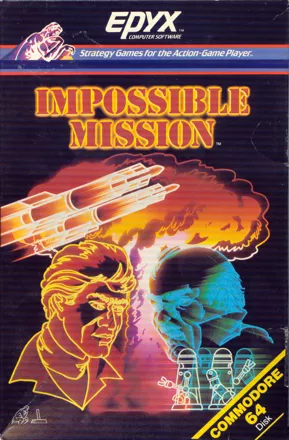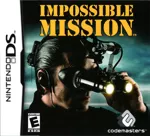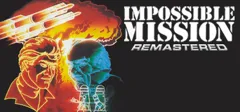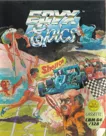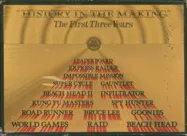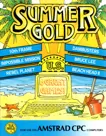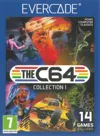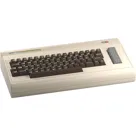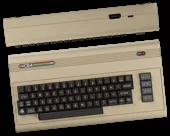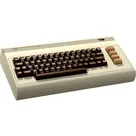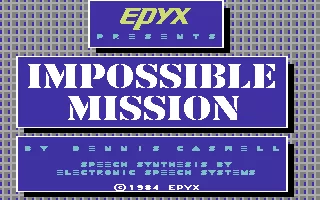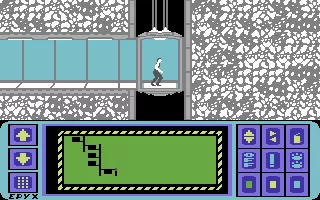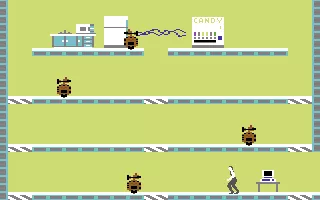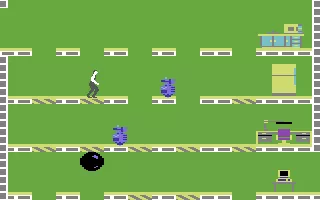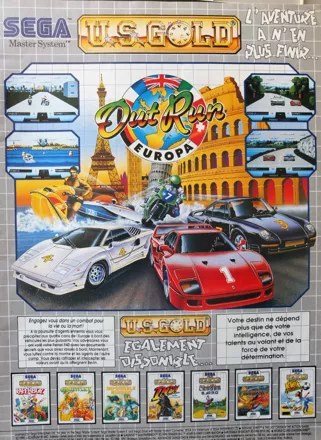Impossible Mission
Description official descriptions
You play a secret agent on a quest to stop the evil Professor Elvin Atombender, who is believed to be tampering with national security computers. You must penetrate Atombender's stronghold, avoid his deadly robot creations, and acquire various pieces of a password to use in the main control room. You have 6 hours to complete the game; 10 minutes are lost each time you die and 2 minutes are expended if you use the help function on your portable computer.
The robots, rooms, and puzzle pieces will be switched around when starting over which provides replay value.
Groups +
Screenshots
Promos
Credits (Commodore 64 version)
| Concept |
Reviews
Critics
Average score: 79% (based on 31 ratings)
Players
Average score: 3.3 out of 5 (based on 44 ratings with 2 reviews)
Made before "they don't make em like they used to" became true
The Good
-slick interface, gameplay
-solid, state-holding game world
-variably programmed robot defenders that extend replay value
-attention to details
-variety of games/challenges
The Bad
-objectives not obvious unless you read the manual
-no difficulty level (it's always very very hard!)
The Bottom Line
"Another visitor! Stay awhile :) Stay FOREVER!"
The real beauty in Impossible Mission isn't the kind of gloss that magazine editors like to splash on their covers and pages, rather it's an intricate balanced challenge that draws the player in and doesn't ever let go.
I still play the original Commodore 64 version of Impossible Mission to this day because no game provides quite the same challenge. I still feel a sense of satisfaction when winning that game, and I still am routinely surprised by how much fun I'm having when I complete some particularly difficult maneuvre.
Put briefly, Impossible Mission enables you to be a secret agent. Now what is so exciting about secret agents? Well, they get into tricky situations quickly, gracefully, and make it look easy. Using the full available speed of the Commodore 64 CPU, this game delivers smooth, precise and surprisingly detailed action. Mis-judge your leap by a half-step and your character will slip off the edge of a platform you had hoped to land on.
The actual physics present in the game are very solid and slick. You will feel at all times like what your character did was what you told it to do. If it dies, it's your fault. On this solid base is built an intricate random puzzle generator. This is the game's replay secret.
The premise of the game is to find dozens of scattered puzzle pieces in an evil scientist's subterranean lair. To find a puzzle piece, your agent avatar navigates near an object that could be hiding a piece and searches it. To do this, it walks, runs, steps and leaps around on horizontal platforms and small movable lifts.
However, the evil scientist has built a mechanised defence system for his lair. In nearly every room you find are advanced, multi-purpose reprogrammable robot sentries. Every time you play the game, the robot's behaviours or randomly chosen out of a set of available action and reaction functions, so that at every stage of the game you are facing a new challenge. The robots can turn, move, kill an avatar by electrical discharge on contact, or in some cases fling an electrified energy field up to 6 feet long that will instantly fry anyone caught in it.
Some of these robots also display unsettling behaviours like occasionally checking their backs or moving left and right to unerringly pinpoint on the player's horizontal location. Their speed, reaction times and electrical fire burst lengths are all variable.
Added to the rolling sentry droid class is a large black electrified floating ball that advanced steadily in your direction at all times. You aren't safe from this one unless there's a wall or other robot between it and you.
Even this detailed description doesn't explain how addictively crafted the game is. The distribution of robot behaviours is not strictly random, but patterned so as to make each room more or less difficult each time you play it. One game a particular room may not threaten so much as a hair on your head while the next game it is an impassable maze of electrified fire.
The layout of each room is obviously hand-tweaked to provide a particular challenge. Some layouts require careful planning and forethought in order to access some levels using the platform lifts. Some layouts feature regularly impossible robot defense combinations that require the player to use a system password to temporarily disable the robots in the room. Considering the memorable nature of many of these rooms, it is probable that the 30 rooms that made it in to the game were chosen from a larger set that was created as potential candidates
At all times, the atmosphere is suffused with convincing sounds that give each room and even each iteration of each room a distinct sound. Not being an expert, I still have a strong suspicion that the background noise is algorithmically generated and that the white noise used during a robot's discharge is digitized speech distorted nearly beyond recognition.
If this review stopped here, then the game wouldn't be the kind that keeps me coming back 17 years after first playing it. The task of defeating the defenses built into the rooms is complemented by a side-game that combines a maze search and logic puzzle. The game even features a music-based sub side-game that replaces two of the 30 rooms in the scientist's layer with machines that generate snooze and platform lift reset passwords. This fascinating and memorable game is a twist on memory and simon says where a sequence of tones is played in random order then hidden under blank tiles, at which point the user has to click the tiles such that the tones sound in ascending order. The game is easy with 3 tiles in the sequence and gets nearly impossible around 9.
The maze search comes in on a small portable computer display panel. This display shows each room that has been visited so far, along with any elevator sections that have been travelled through to date. Not all rooms allow passage through them, and some that are connected are impassable from certain directions or if the platforms are moved into an obstructive pattern. Oh, did I forget to mention that the state of each platform in each room is preserved throughout the game? Little touches like this add to the realism of the game world.
The last sub-game is a true unique in action games. The author has created a puzzle-generation algorithm that routinely produces familiar-looking yet somewhat dissimilar game pieces. As you play the game again and again, you see regular patterns emerge in the shapes of puzzle pieces presented to you. To complete this phase of the game, you must first have all the puzzle pieces in all rooms collected, then use an intuitive user interface in your portable computer to match up puzzle pieces in groups of 4. Each puzzle completed gives a letter in an 8 letter master password that unlocks the scientist's programming lab entrance.
Oh, one last thing. All this sleuthing and puzzling is being done to prevent the scientist from carrying out some diabolical action at 6pm. The game begins at noon. Six hours seems like a lot of time, except that every time your spy avatar gets killed by a robot or by falling down a mechanical shaft, you lose ten minutes in regeneration time. Don't worry about losing track of time since your personal computer conveniently tells it to you.
And every time an hour goes by, you'll hear the scientist's voice ring out over the PA system when you next enter a room:
"Destroy him, my robots!"
Commodore 64 · by carl brennan (2) · 2004
A real 1984 standout and a milestone of game history, very hard, but fun.
The Good
I didn't play Impossible Mission the year it came out, but in 1990 on the school Commodores. Was fun, but I was hopeless at solving the password puzzles, couldn't even get one letter of the password. Looking back at mid-1984, Impossible Mission had a new depth and creativity among games of both arcade and home.
The game is kind of an adaptation of Rogue, except with a major viewpoint change, you have a side view of the cross-section of a large multi-story building. It's not sword & sorcery or even guns and grenades, the hero's main weapon is acrobatics to dodge the enemy robots. It's VERY easy to be zapped by a robot or die by coming into contact with one. Some robots are smarter than others and/or more aggressive. You have to be patient and studious to figure out how to dodge them. That, combined with the overlapping film strip puzzle solving makes this very much a puzzle solver game. The setup is sort of like a comic villain's challenge, he's given you the seemingly impossible task of finding 36 puzzle pieces hidden in furniture guarded by robots, scattered among the rooms.
I think the overall concept is great, there's only one mission, but it takes a lot of failures, hopefully learning a little more each time, to finally solve all 9 password puzzles and get to the door of Elvin Atombender's control room before "Doomsday".
The Bad
The game tries the patience pretty hard and while you don't have lives to lose you suffer a pretty hefty time penalty and when you're a beginner you can soon give up hope of getting anywhere near finishing and have to accept the progress of gaining two or three password puzzles. But the thing is, even an experienced player who knows all the rooms, the puzzle pieces and the different robot behaviour can be dealt a really cruel hand at the start by the game's reorganization. You can end up with many alert and aggressive robots guarding furniture and potential puzzle pieces seemingly impossible to get to without a lot of time and patience or a "snooze password" to temporarily deactivate the robots, but then can find no snoozes nearby. So bad luck could make the mission literally impossible even for an expert.
One little thing that I think would've helped is making the building circular like in Impossible Mission II so that you can loop back to the first column of rooms if you get to the last and find that you've missed some puzzle pieces. Another fair piece of assistance would be marking on the map, not just rooms you've entered, but rooms you've searched thoroughly.
The Bottom Line
OK, so the recent remastering of this game available on Steam seems not inferior to the original, except that they've cut off the graphic of Elvin in his control room ("No! No! No!"), so that after his door opens, the screen crossfades to the "Mission Terminated" screen. I mean, as meagre as an ancient C64 graphic of an angry, defeated mad scientist and a "Mission Complete" screen seems today, it's a lot more satisfying than "Mission Terminated" after slaving away for weeks to get to the end.
But the game is definitely a milestone of game history. For those who play it, here's some advice for solving the password puzzles. I think it's best to have about the first half of your puzzle pieces' orientation corrected over the phone and using that to determine the orientation of the matching pieces, not bothering so much to use the other over the phone help i.e. asking if you have enough pieces to finish one of the puzzles. I got much quicker at matching puzzle pieces by the time I finished the game.
Commodore 64 · by Andrew Fisher (700) · 2021
Trivia
Atari 7800 version
On the Atari 7800, the name of the game can be taken literally. Due to a bug in the program the NTSC release cannot not be completed. Some of the items you need are hidden under terminals that cannot be searched. This was fixed for the PAL release.
Commodore 64 PAL and NTSC versions
Originally the game was released in USA in NTSC version by CBS. A few months after the premiere it was also published in Europe in PAL version by US Gold. However it was released with a glitch resulting from the positioning of the code for the electricity bolts. If a robot's firing pattern calls for it to shoot on the far left of the screen, the agent would be fried no matter where in the room he was. Eventually US Gold patched the game to prevent the robots firing in this situation but a proper fix was implemented in 1997 by cracking group Remember.
Development
According to Dennis Caswell, the development of the game took about ten months. The idea behind came up from the movie War Games - the HAL-like computer led to the idea of a platform game in which the player was required to infiltrate a computer-controlled complex. The first thing that was created was the animation of the running man. For a long time the game had no title. It had changed prior to the release where somebody noticed the similarity to the TV show Mission: Impossible but due to obvious reasons it could not be used. Author cheated and gave it a title that was legal while still creating the desired association. The graphics were drawn on graph paper and converted into hex strings that were hand-typed into the code.
References to the game
The title of the German computer games podcast Stay Forever by former gaming journalists Christian Schmidt and Gunnar Lott is inspired by the synthesized speech "Stay a while...stay forever!" from this game. The voice is also used in the podcast's intro.
Speech
On the Commodore 64 version. The game is well known for the use of synthesized speech. Electronic Speech Synthesis (the company that developed the sampled speech for the game) used this game as a test sample.
When this sample was a successful game, Electronic Speech Synthesis (ESS) significantly raised their prices. This caused Epyx to never use their services again (although Impossible Mission II uses ESS, Novotrade developed the game, and they were the same sampled speech tracks used in this game).
Awards
- ACE (Advanced Computer Entertainment)
- February 1991 (issue #41) - Included in the list Greatest Games of all Time, section Platform-based Games (editorial staff choice)
- Commodore Force
- December 1993 (Issue 13) – #50 “Readers' Top 100”
- FLUX
- Issue #4 - #92 in the "Top 100 Video Games of All-Time" list
- GameStar (Germany)
- Issue 03/2013 – Issue 03/2013 – One of the "Ten Best C64 Games"
- Happy Computer
- Issue 02/1986 - #7 Best Game in 1985 (Readers' Vote)
- Retro Gamer
- October 2004 (Issue #9) – #45 Best Game Of All Time (Readers' Vote)
- Issue 37 - #12 in the "Top 25 Platformers of All Time" poll* Zzap!
- May 1985 (Issue 1) - #2 'It's the Zzap! 64 Top 64!'
Information also contributed by Big John WV, PCGamer77 and Scott G
Analytics
Related Sites +
-
CPC-Power (in French)
For Amstrad CPC: game database entry; game packaging; manual digitalizations; goodies; advertisement; magazine reviews; downloadable releases; additional material. -
CPCRrulez (in French)
For Amstrad CPC: game database entry; advertisement; game packaging; downloadable releases; additional material. -
Cambridge Centre for Computing History (C64)
For Commodore 64, Cassette: exhibit reference ID CH14491; additional material. -
Cambridge Centre for Computing History (Epyx Computer Software, BBC Micro)
For BBC Micro, Cassette: exhibit reference ID CH4357; additional material. -
Cambridge Centre for Computing History (Epyx Computer Software, BBC Micro)
For BBC Micro, 5.25" Floppy Disk: exhibit reference ID CH21360; additional material. -
Cambridge Centre for Computing History (Epyx, Amstrad CPC)
For Amstrad CPC464, Cassette: exhibit reference ID CH41484; additional material. -
Cambridge Centre for Computing History (Ricochet, Amstrad CPC/Spectrum)
Dual Amstrad/Spectrum cassette. Ricochet re release. For Amstrad CPC464/Spectrum, Cassette: exhibit reference ID CH30858; additional material. -
Commodore 64 Boxed Sets
For C64: game packaging digitalisations. Include box, manual, brochure, additional material. -
Impossible Mission
Site with screenshots of each version, trivia, tips, and the original manual. -
Kio's home
For ZX Spectrum: additional material including – photographed cassette inlay; snapshots; downloadable releases. -
Lemon 64
For C64: game entry database; advertisement; magazine reviews; music; documentation; cover art; additional material. -
Replacementdocs (Sega Master System, Manual)
Documentation for Sega Master System. -
Replacementdocs (ZX Spectrum, UK Manual)
Documentation for ZX Spectrum. -
SMS Power! (Sega Master System)
For Sega Master System: releases info; credits; box text; additional material. -
The End Zone
Dedicated to end of game sequences with the objective of providing the most definitive and complete 'end of game' information ever assembled for the games featured. -
The Tipshop
For ZX Spectrum/SAM: a central archive for all Spectrum and SAM games hints, tips, cheats, maps, hacks and pokes. -
World of Spectrum
For ZX Spectrum: downloadable releases; additional material including – cassette inlay, advertisement, instructions; remakes links; player reviews; magazine references; magazine adverts. -
ZX Spectrum Reviews
For ZX Spectrum: magazine game reviews in HTML.
Identifiers +
Contribute
Are you familiar with this game? Help document and preserve this entry in video game history! If your contribution is approved, you will earn points and be credited as a contributor.
Contributors to this Entry
Game added by RKL.
BBC Micro added by Trypticon. Antstream added by firefang9212. Electron, Sharp X1, ZX Spectrum added by Kabushi. Wii added by gamewarrior. PC-88 added by Terok Nor. Apple II, Amstrad CPC added by Servo.
Additional contributors: Martin Smith, c64fan, Patrick Bregger, mailmanppa, Jo ST, FatherJack, ZeTomes.
Game added December 6, 2003. Last modified March 1, 2025.


